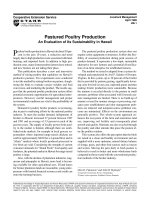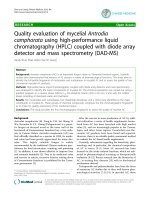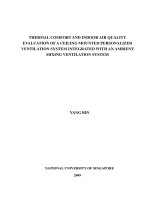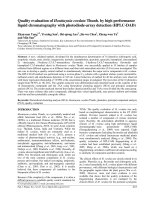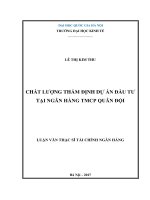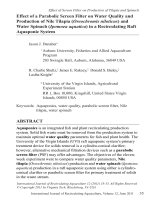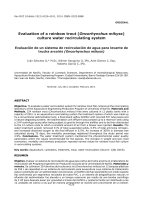Quality evaluation of osmosed jackfruit bulb slices
Bạn đang xem bản rút gọn của tài liệu. Xem và tải ngay bản đầy đủ của tài liệu tại đây (235.73 KB, 7 trang )
Int.J.Curr.Microbiol.App.Sci (2019) 8(5): 466-472
International Journal of Current Microbiology and Applied Sciences
ISSN: 2319-7706 Volume 8 Number 05 (2019)
Journal homepage:
Original Research Article
/>
Quality Evaluation of Osmosed Jackfruit Bulb Slices
K. Mithun1* and S. Kaleemullah2
1
Dr. NTR College of Agricultural Engineering, ANGRAU, Bapatla, India
2
PHET Center, RARS, ANGRAU, Tirupati, India
*Corresponding author
ABSTRACT
Keywords
Jackfruit bulb
slices, Osmotic
dewatering, Quality
evaluation
Article Info
Accepted:
04 April 2019
Available Online:
10 May 2019
The present study was carried out to determine the quality and sensory
parameters of osmotic dewatered jackfruit bulb slices at optimized
condition. The quality parameters like colour, hardness, ascorbic acid
content and sensory parameters like appearance, odour, taste and overall
acceptability were studied. The results showed that the osmotic dewatering
process has significant effect on the quality and sensory parameters
respectively. The significant being positive in both the quality and sensory
parameters are observed. The osmotic dewatering process has proved to be
one of the best processing technique without compromising on the quality.
The area under cultivation and production of
jackfruit in India is 1,87,000 ha and 18,57,000
MT for the year 2018-2019 (Indiast at, 2019).
Jackfruit is available round the year in Panruti
of Tamil Nadu, Idukki district of Kerala and
Tumku rof Karnataka (Down To Earth, 2018).
Introduction
Jackfruit (Artocarpus heterophyllus L.) the
largest tree-borne fruit, is a native of South
and Southeast Asia. India, Bangladesh, and
Thailand are the largest producers of jackfruit
in the global village. India is the global leader
in jackfruit production in the global village.
Jackfruit, popularly known as “poor man’s
fruit” is the most under-utilized fruit. The
largest jackfruit producing states in the
country are Tripura, Odisha, Assam, West
Bengal, Chhattisgarh, Jharkhand, Madhya
Pradesh, Tamil Nadu, Andhra Pradesh,
Kerala, Telangana, Karnataka. Jackfruit is the
national fruit of Bangladesh and Kerala has
declared it as its state fruit (George, 2018).
According to the UN Food and Agricultural
Organization, 75% of the jackfruit produced
in India, gets spoiled due to the lack of proper
processing facilities (Worldatlas, 2017). The
jackfruit produced during peak season if
processed fetches revenue to the farmers by
selling them in the glut season. Thus the
development of value added products from
jackfruit have become inevitable.
466
Int.J.Curr.Microbiol.App.Sci (2019) 8(5): 466-472
Osmotic dewatering process is the novel food
processing operation to dehydrate the fruits,
vegetables and meat products. Osmotic
dewatering process is a partial water removal
process. The osmotic dewatering process aids
in reduced weight of the product, reduction in
the consumable space during transportation,
increased shelf life and a retained quality of
the product (Sahu et al., 2017). The water loss
and the solid gain are the two important mass
transfer operations generally occur in the
osmotic dehydrated process. Thus osmotic
dewatering process has added advantages
over general drying of jackfruit.
eliminate dirt or dust adhered to it. The
jackfruits were cut manually using a SS knife
and the bulbs were separated manually
without the application of any edible oil. The
seeds were parted from the bulb manually by
vertical slitting using a knife. The bulbs were
cut into uniform square shape (2×2 cm) slices
with average thickness of 4.5 mm.
Physico-chemical analysis
Moisture content of fresh jackfruit bulb slices
was determined by AOAC (2005). Total
soluble solids (TSS) were measured by hand
refractometer (Atago, Tokyo) by grinding the
slices in mortar with pestle. The pH and
titratable acidity of fresh fruit were
determined by the methods given by
Ranganna (1986). Sampling was done in
triplicate.
In India, majority of the food processing
industries engages osmotic dehydration
technique to remove moisture from fruits and
vegetables because osmotic dehydration
methods retains the flavour, colour, texture
and shelf-life of processed product (Sutar and
Gupta, 2007).
Preparation of osmotic solution
Osmotic dehydration is generally used as a
pre-treatment by many food processors prior
to freezing, freeze drying, vacuum drying and
air drying (Nanjundaswamy et al., 1978). The
rate of transfer of water from material to the
solution depends upon several factors such as
solution concentration, temperature, shape
and size of the material and method of
agitation.
Commercial sugar was used as solute in the
osmotic solution. The osmotic solution of
contributed are 60 °B at a temperature of 57
°C and immerged for 160 min. Preservatives
like citric acid (0.3% w/v, food grade) and
potassium metabisulfite (1% w/v, food grade)
were added to the osmotic solution.
Experiments were conducted at fruit to
solution ratio of 1:4.
Therefore an attempt was made to determine
the quality of osmotic dewatered jack fruit
bulb slices. The quality parameters were
determined at the optimized condition of
osmotic dewatering process. Thus, the
osmotic dewatered jackfruit bulb slices
quality was compared to that of the fresh one.
Osmotic dewatering process
Twenty five grams of jackfruit bulb slices
were immerged in osmotic solution contained
in stainless steel container. The container is
kept in thermostat-controlled oven. The
movement of water and sugar was analysed
by calculating water loss (WL) and solid gain
(SG). After osmotic dehydration process, the
jackfruit slices were taken out of the solution,
rubbed gently with muslin cloth to remove the
adhered solute on their surfaces and were
weighed immediately. The slices were
Materials and Methods
Raw material
Matured jackfruits, obtained from local
market were washed in running water to
467
Int.J.Curr.Microbiol.App.Sci (2019) 8(5): 466-472
weighed and moisture content was determined
by using vacuum oven (AOAC 2005).
L*, a*, b* = chromaticity values for treated
fruit jackfruit bulb slice
Hardness
Ascorbic acid content
The hardness of the fresh and osmotic
dewatered samples was determined by
Texture analyser (Brookfield Engineering
Labs, Inc., USA) compression tests. It was
equipped with 12.7 mm dia. stainless steel
ball probe (TA18) (Fig. 1) operated at pre-test
speed of 1 mm s-1, test speed and post-test of
0.5 mm s-1. Load cell of 5 kg was used to
fracture the slice.
Ascorbic acid content (Fig. 2) of the samples
was determined by the method described by
AOAC (2005).
Sensory evaluation
Sensory evaluation of samples was carried out
for consumer acceptance and preference using
10 untrained panelists selected at random.
Appearance, flavour, overall acceptability of
the samples were rated using a 9-point
Hedonic scale (Beckley et al., 2012).
Colour
Colour of fresh and treated slices was
measured using Hunter Lab Color Flex
spectrophotometer (Hunter Lab Associates
Laboratory, USA). The measurement was
done with an illuminate observer combination
of D65/10°. The surface colour was quantified
in terms of L*, a* and b* values of CIELAB
colour space. The CIELAB colour space is
organised in a cube form, where L* axis runs
from top to bottom with minimum value of 0,
representing black and maximum of 100
representing white. The axis –a*, +a* goes
from green to red and the axis –b*, +b* goes
from blue to yellow. The samples were placed
over the port. The instrument was
standardised with white and black ceramic
tiles before starting the measurement. The
colour of sample was measured by measuring
L*, a* and b* values. The total colour
difference is calculated by below given
equation,
Sensory evaluation was carried out at ambient
conditions in a comfortable and quiet area
without disturbance under fluorescent
lighting. Water was supplied to cleanse palate
between samples. Four sensory attributes
stated below were considered for the study
(Table 1).
Results and Discussion
Physio-chemical analysis
The total soluble solids (TSS), pH and
titratable acidity of fresh jackfruit bulb slices
were recorded as 28 °B, 5.2 and 2.4,
respectively. The initial moisture content of
the jackfruit bulb slices was recorded around
200% (d.b.). Moisture content of jackfruit
bulb slices after osmotic dehydration was
around 100% (d.b.).
The values pertaining to the quality
parameters were represented in the Table 2.
Hardness, yellow chromaticity, total colour
difference, ascorbic acid content, appearance,
odour, taste, overall acceptability of fresh and
osmotic dewatered jackfruit bulb slices were
tabulated.
where,
L, a, b = chromaticity values for fresh
jackfruit bulb slice
468
Int.J.Curr.Microbiol.App.Sci (2019) 8(5): 466-472
Table.1 Score card for sensory attributes during sensory evaluation
Sensory attributes
Appearance
Odour
Taste
Overall
acceptability
Opinion
Like extremely
Like very much
Like moderately
Like slightly
Neither like nor dislike
Dislike slightly
Dislike moderately
Dislike very much
Dislike extremely
Score
9
8
7
6
5
4
3
2
1
(Source: Beckley et al., 2012)
Table.2 Score values for quality parameters of fresh and osmotic dewatered jackfruit bulb slices
Quality parameter
Hardness (N)
Yellow chromaticity (b*)
Total colour difference (ΔE)
Ascorbic acid content (mg/100
g)
Appearance
Odour
Taste
Overall acceptability
Fresh sample
37±1
48.60±1.33
9.82±0.18
Osmotic dewatered sample
50±1
49.69±5.48
2.86±4.15
5.56±0.51
7.2±0.6
8.1±0.7
6.6±0.7
6.8±1.0
6.9±0.9
8.0±1.1
8.0±0.9
7.0±0.8
Fig.1 SS ball probe fitted to texture analyzer
469
Int.J.Curr.Microbiol.App.Sci (2019) 8(5): 466-472
Fig.2 Flow chart for estimation of ascorbic acid
Take 5 g of sample
4% of oxalic acid
Make up volume to 100 ml
Filter
5 ml of aliquot
Add 10 ml of 4% oxalic acid
Titrate against 2,6 - Dichloroindophenol dye
Pink colour end point
helped in colour enhancement. These results
are in agreement with strawberries (GarciaNoguera et al., 2014)
Hardness
The hardness of the fresh jackfruit bulb slices
and osmotic dewatered sample were 37±1 and
50±1 respectively. The increase in the
hardness might be due to the diffusion of
sugar into the jackfruit slice, which made it
firm in texture. Similar results were drawn by
Knezevic et al., (2013) in case of pork meat.
Ascorbic acid content
The ascorbic acid content of fresh and
osmotic dehydrated jackfruit bulb slices were
9.82±0.18 and 5.56±0.51 respectively. This
clearly indicates that the osmotic dewatering
process aids in ascorbic acid loss during
diffusion process. Similar results were
observed in case of pears (Nadia et al., 2013)
and majority of the fruits and vegetables
(Santos and Silva, 2008).
Colour
The yellow chromaticity (b*) values for fresh
and osmotic dehydrated jackfruit bulb slices
were 48.60±1.33 and 49.69±5.48 respectively.
The improvement in yellow colour might be
due to the reason that the sugar on heating
contributes creamy yellow appearance. The
layer of sugar coated on jackfruit bulb slices,
during the diffusion process, might have
Sensory evaluation
The appearance, taste, odour and overall
acceptability of fresh and osmotic dehydrated
470
Int.J.Curr.Microbiol.App.Sci (2019) 8(5): 466-472
jackfruit bulb slices were 7.2±0.6, 6.6±0.7,
8.1±0.7, 6.8±1.0 and 6.9±0.9, 8.0±0.9,
8.0±1.1, 7.0±0.8 respectively. The increase in
taste perception is due to the increased sugar
content during solid gain phenomena of
osmotic dewatering process. There is slight
improvement in appearance, this might be due
to the yellow colour of the sugar solution.
There is no change in odour, because, the
jackfruit has strong fragrance. The overall
acceptability of osmotic dewatered jackfruit
bulb slices is greater when compared to fresh
jackfruit bulb slices. The odour and taste
quality perceptions are in agreement with
Azoubel et al., (2009) in the case of cashew
apple, but the appearance perception is
contradictory with the present investigations.
Azoubel, PM., El-Aouar AA, Tonon RV,
Kurozawa LE, Antonio GC, Murr
FEX and Park KJ. 2009. Effect of
osmotic dehydration on the drying
kinetics and quality of cashew apple
International Journal of Food Science
and Technology. 44: 980-986
Beckley, J., Paredes D and Lopetcharat K.
2012. Product Innovation Tool Box: A
Field
Guide
to
Consumer
Understanding and Research. WileyBlackwell, USA.
Down To Earth. 2018. The jackfruit will
definitely become the most soughtafter fruit in the coming years in India.
(Accessed 21st March 2019)
/>od/-the-jackfruit-will-definitelybecome-the-most-sought-after-fruitin-the-coming-years-in-india--50450
Garcia-Noguera J., Oliveira FIP, Weller CL,
Rodrigues S and Fernandes FAN.
2014. Effect of ultrasonic and osmotic
dehydration pre-treatments on the
colour of freeze dried strawberries.
Journal of Food Science and
Technology.
51(9):
2222–
2227.doi: 10.1007/s13197-012-0724-x
George, MPJ., 2018. The jackfruit board bill.
Bill No. 153 of 2018. (Accessed 21st
March 2019). http://164.100.47.4/
billstexts/lsbilltexts/asintroduced/1833
LS%20AS%20INTRO.pdf
Indiastat. 2019. Area and production of
jackfruit in India (1st Advance
Estimates). (Accessed 2nd April 2019)
Knezevic, V., Curcic B, Filipovic V, Nicetin
M, Levic L, Kuljanin T and Gubic J.
2013.
Influence
of
osmotic
dehydration on colour and texture of
pork meat. Journal on Processing and
Energy in Agriculture. 17(1): 38-42
Nadia, DM., Nourhène BM, Nabil K, Francis
C and Catherine B. 2013. Effect of
Osmo-dehydration Conditions on the
Quality Attributes of Pears. J Food
In conclusion, the osmotic dewatering process
has shown significant effect on the quality of
jackfruit bulb slices. The quality parameters
like hardness, ascorbic acid content, colour,
appearance, taste, odour and overall
acceptability were determined. The osmotic
dewatering process showed positive effect on
the hardness, colour, appearance, taste and
negative effect on ascorbic acid content. The
overall acceptability of the osmotic dewatered
jackfruit bulb slices was recorded high. Thus
the osmotic dewatering process aids in a
superior quality product. Thus osmotic
dewatering or osmotic dehydration technique
can be adopted on wide variety of perishable
foods.
Acknowledgement
The authors acknowledge the endorsement
received in the form of procurement of
material, equipment, facilities provided by
Acharya N.G. Ranga Agricultural University.
References
AOAC., 2005. Official methods of analysis.
18th ed. Association of Official
Analytical Chemists, USA.
471
Int.J.Curr.Microbiol.App.Sci (2019) 8(5): 466-472
Process
Technol
4:256.
doi:
10.4172/2157-7110.1000256
PHS Santos and MA Silva. 2008. Retention of
Vitamin C in Drying Processes of
Fruits and Vegetables-A Review.
Drying Technology 26(12): 1421-1437
Ranganna, S., 1986. Handbook of Analysis
and Quality Control for Fruit and
Vegetable Products.2nd Ed. Tata
McGraw-Hill, New Delhi.
Sahu, G., Vinoda N, Monisha P, Paradkar V
and Kumar N. 2017. Studies on drying
of osmotically dehydrated onion
slices. Int. J. Curr. Microbiol. App.
Sci. 6(9): xx-xx. doi: />10.20546/ijcmas.2017.60 9.xx
Sutar, PP., and Gupta DK. 2007.
Mathematical modeling of mass
transfer in osmotic dehydration of
onion slices. Journal of Food
Engineering. 78: 90-97
Worldatlas, 2017. World leaders in jackfruit
production. (Accessed 21st March
2019)
/>
How to cite this article:
Mithun K. and Kaleemullah., S. 2019. Quality Evaluation of Osmosed Jackfruit Bulb Slices.
Int.J.Curr.Microbiol.App.Sci. 8(05): 466-472. doi: />
472

